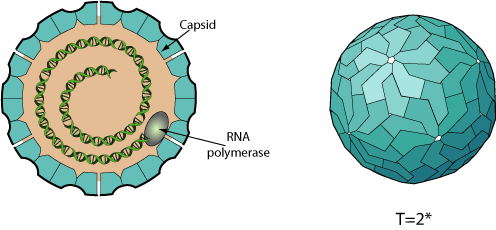Giardiavirus (taxid:11011)
VIRION

Non enveloped, icosahedral virion composed of a single capsid protein (CP), about 36 nm in diameter. The capsid has a T=2* icosahedral symmetry.
GENOME
Linear dsRNA genome of 6277 bp. Contains 2 overlapping ORFs gag and pol, respectively encoding CP and RdRp.
GENE EXPRESSION
The dsRNA genome is never completely uncoated, to prevent activation of antiviral state by the cell in response to dsRNA. The viral polymerase synthesizes a mRNA, which is translocated to the cell cytoplasm where it is translated.
Translation is initiated on a unique internal ribosome entry site internal ribosome entry site (IRES) element situated at the 5'-UTR.
The plus-strand viral transcript is flanked by a 367-nt untranslated
region (5'-UTR) and a 301-nt 3'-UTR and directs the translation of a major 100-kDa CP (Gag) and a minor 190-kDa fusion protein CP-RdRP (Gag-Pol) via a -1 ribosomal frameshift.
ENZYMES
- RNA-dependent RNA polymerase [POL]
- No capping activity (IRES)
REPLICATION
CYTOPLASMIC
- Attachement to host receptors mediates endocytosis of virus into host cell.
- Transcription of the dsRNA genome by viral polymerase occurs inside the virion, so that dsRNA is never exposed to the cytoplasm. This plus-strand transcript is used as template for translation.
- (+)RNAs are encapsidated in a sub-viral particle, in which they are transcribed to give RNA (-) molecules with which they become base-paired to produce dsRNA genomes.
- Mature virions are released, possibly by exocytosis.
Matching UniProtKB/Swiss-Prot entries
(all links/actions below point to uniprot.org website)2 entries grouped by protein
1 entry
Major capsid protein (Gag protein) (Major coat protein)
1 entry
Probable RNA-directed RNA polymerase (EC 2.7.7.48) (Gag-Pol protein)
Giardia lamblia virus (isolate Wang) taxid:649893
| Protein | ModelArchive |
| Major capsid protein (Gag protein) (Major coat protein) | ma-jd-viral-42162 |
